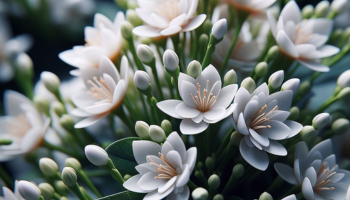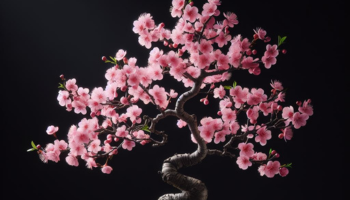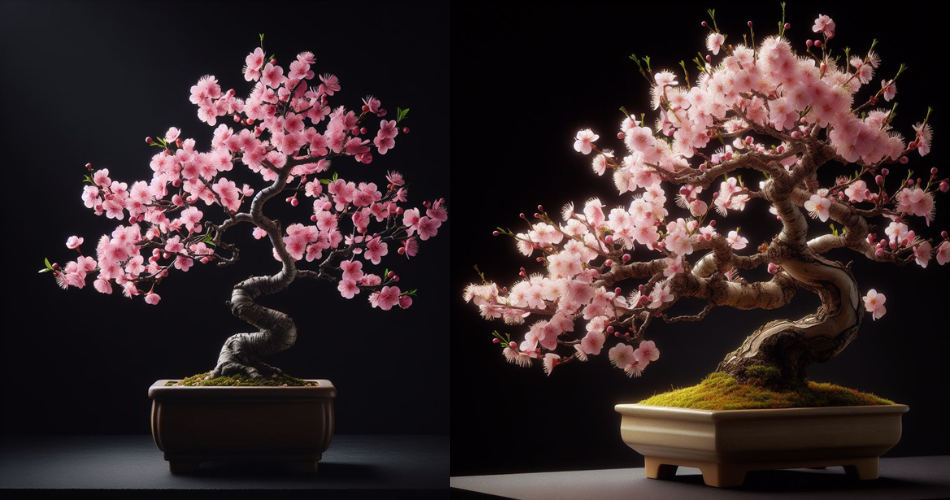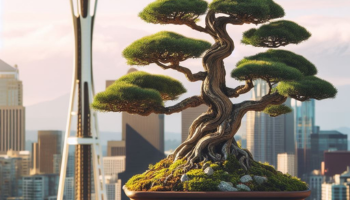
Water Jasmine (Wrightia religiosa) is a beautiful and versatile plant that is popular among gardening enthusiasts. With its delicate white flowers and glossy green leaves, this evergreen shrub adds a touch of elegance to any indoor or outdoor space. However, to ensure the health and longevity of your water jasmine plant, it is important to understand its specific care requirements. From choosing the right environment to mastering watering techniques and managing pests, this article will provide you with a comprehensive guide on how to properly take care of a water jasmine plant. Whether you are a beginner or an experienced gardener, this article will equip you with the knowledge and tips needed to cultivate a thriving water jasmine plant.
1.1 What is a Water Jasmine Plant?
Picture this: a delicate, green vine with small, elliptical leaves and tiny, charming white flowers. That, my friend, is the water jasmine plant. Also known as Wrightia religiosa, this plant is a popular choice among plant enthusiasts for its beauty and ease of care.
1.2 Benefits of Growing Water Jasmine
Apart from being a treat for the eyes, water jasmine plants offer numerous benefits. They are excellent air purifiers, helping to improve the air quality in your home or office. Plus, their fragrance is simply divine, filling the air with a sweet and pleasant scent.
1.3 Popular Varieties of Water Jasmine
Water jasmine plants come in a variety of forms, each with its own unique characteristics. Some popular varieties include “Variegata,” which features leaves with striking cream and green patterns, and “Alba,” known for its pure white blossoms. Whether you prefer a splash of color or a classic look, there’s a water jasmine variety to suit your taste.
2. Choosing the Right Environment for Water Jasmine
2.1 Indoor vs. Outdoor Growing
Deciding whether to grow your water jasmine plant indoors or outdoors depends on your location and climate. If you live in a warmer region, you can enjoy the luxury of growing your water jasmine outdoors, allowing it to bask in the natural sunlight. However, if you reside in a cooler area, it’s best to keep your water jasmine indoors, where you can control the temperature more easily.
2.2 Light Requirements for Water Jasmine
Like many plants, water jasmine thrives in bright, indirect light. It’s essential to place your plant in a spot where it can receive plenty of sunshine without being exposed to harsh, direct sunlight. A sunny windowsill or a well-lit corner of a room are great options to keep your water jasmine happy and healthy.
2.3 Temperature and Humidity Considerations
Water jasmine plants prefer temperatures between 65°F to 85°F (18°C to 29°C). Avoid exposing your plant to drastic temperature changes, as it can lead to stress and damage. Additionally, maintaining a humid environment is crucial for the well-being of your water jasmine. If the air in your home is dry, consider using a humidifier or placing a tray filled with water near the plant to increase moisture levels.
3. Watering and Moisture Requirements
3.1 Understanding Watering Needs
Watering your water jasmine plant can sometimes be a bit tricky. These plants prefer to be slightly moist but not waterlogged. Overwatering can lead to root rot, while underwatering can cause the plant to wither. Striking the right balance is key – just like watering a demanding houseplant, but with a bit more finesse.
3.2 Frequency and Amount of Watering
As a general rule, water your water jasmine when the top inch of the soil feels slightly dry to the touch. Give it a good drink, allowing excess water to drain away, and avoid letting the plant sit in standing water. Remember, it’s always better to underwater than overwater, so resist the temptation to drown your beautiful water jasmine.
3.3 Tips for Properly Moisturizing the Soil
To help maintain moisture levels and prevent the soil from drying out too quickly, consider adding a layer of organic mulch around the base of your water jasmine plant. This will help retain moisture and protect the roots. Additionally, misting the leaves occasionally or placing a tray of water nearby can provide a little extra humidity, which water jasmine plants adore.
4. Sunlight and Temperature Needs
4.1 Ideal Sunlight Conditions for Water Jasmine
While water jasmine plants enjoy bright light, they prefer to be shielded from direct sunlight. Strive for a location that offers filtered or indirect light. This can be achieved by placing them near a sheer curtain or in a spot that receives bright, indirect light throughout the day. Avoid harsh afternoon sun, as it can scorch the leaves.
4.2 Importance of Temperature Control
Water jasmine plants are happiest in temperatures between 65°F to 85°F (18°C to 29°C). Keep them away from cold drafts, such as open windows on chilly nights, as they can cause the plant to suffer. Additionally, avoid placing the plant near heaters or vents, as the dry, hot air can dehydrate the leaves and disrupt their growth.
4.3 Protecting Water Jasmine from Extreme Weather
Extreme weather conditions, such as frost or excessive heat, can put stress on your water jasmine plant. If you’re growing it outdoors, it’s crucial to monitor the weather forecast and take necessary precautions. Consider covering the plant during colder nights or providing shade during scorching summer days to shield it from the harshest elements.
Taking care of a water jasmine plant is an enjoyable and rewarding experience. With a little attention to its light, temperature, and watering needs, you’ll have a thriving and beautiful addition to your indoor or outdoor space. So get ready to nurture your green thumb and enjoy the beauty of this delightful plant.
5. Soil and Fertilizer Considerations
5.1 Choosing the Right Soil Mix
When it comes to taking care of your water jasmine plant, one of the first things to consider is the soil. Water jasmine thrives in well-draining soil that is rich in organic matter. You want to create an environment that allows water to freely flow through the soil while retaining enough moisture for the plant’s roots.
To achieve this, a good soil mix for water jasmine consists of equal parts peat moss, perlite, and regular potting soil. This combination provides the perfect balance of moisture retention and drainage, ensuring that your plant’s roots can grow and breathe.
5.2 Understanding Fertilizer Needs
Water jasmine plants, like many other houseplants, benefit from regular fertilization. However, it’s important to understand their specific fertilizer needs to avoid over or underfeeding.
Water jasmine plants prefer a balanced, all-purpose fertilizer with an NPK ratio of around 10-10-10. This means the fertilizer contains equal amounts of nitrogen (N), phosphorus (P), and potassium (K). Look for a slow-release fertilizer or one that is specifically formulated for indoor plants.
5.3 Best Fertilizer Practices for Water Jasmine
Now that you have the right fertilizer, it’s essential to know how and when to apply it to your water jasmine plant. During the active growing season, which is typically spring and summer, fertilize your plant every two to four weeks. Dilute the fertilizer according to the instructions on the packaging and apply it directly to the soil. Avoid getting the fertilizer on the leaves or stems, as it can cause burns.
During the dormant season, which is usually fall and winter, reduce the frequency of fertilization to once every two months. This allows your water jasmine to rest and prepare for new growth in the following season.
6.1 Why Pruning is Important for Water Jasmine
Pruning is an essential part of water jasmine plant care. It not only helps maintain the plant’s shape and appearance but also promotes healthy growth and prevents overcrowding.
Regular pruning allows you to remove dead or damaged branches, which helps prevent the spread of diseases and pests. It also encourages new growth and improves the overall aesthetic of your water jasmine plant.
6.2 How to Prune Water Jasmine Properly
When it comes to pruning water jasmine, less is more. Start by removing any dead, yellowing, or diseased leaves or branches. Use clean and sharp pruning shears to make clean cuts, as jagged cuts can invite infections.
To encourage branching and bushier growth, selectively prune the tips of the stems. This will stimulate lateral bud growth and result in a fuller and more compact plant. Remember to step back and observe the plant’s overall shape as you prune, ensuring a balanced and visually appealing appearance.
6.3 Training Water Jasmine for Desired Shape
If you have a specific shape or form in mind for your water jasmine, it’s possible to train the plant to grow in that manner. Start by gently bending and tying the stems to the desired support structure, such as a trellis or stake.
As the plant grows, continue adjusting and securing the stems to maintain the desired shape. Be patient, as it may take time for the plant to adapt and grow in the desired direction. Regular pruning and training will help you achieve the look you want for your water jasmine.
Common Pests and Diseases
7.1 Identifying Common Pests for Water Jasmine
Just like any other plant, water jasmine is susceptible to pests. The most common ones include aphids, mealybugs, and spider mites. Keep an eye out for signs such as sticky residue, yellowing leaves, or visible insects.
Aphids are tiny, pear-shaped insects that cluster on new growth, sucking sap from the plant. Mealybugs appear as small white cottony patches on stems and leaves, while spider mites cause webbing and stippled leaves.
7.2 Preventing and Treating Pest Infestations
To prevent pest infestations, regularly inspect your water jasmine plant for any signs of trouble. If you notice pests, you can try removing them manually with a cotton swab dipped in rubbing alcohol. For larger infestations, use an insecticidal soap or neem oil solution, following the instructions on the product.
To minimize the risk of pests, ensure good plant hygiene by removing any dead leaves or debris from the plant’s vicinity. Additionally, avoid overwatering, as it can create a favorable environment for pests to thrive.
7.3 Common Diseases and How to Manage Them
Water jasmine plants can be prone to a few common diseases, such as powdery mildew and root rot. Powdery mildew appears as a white powdery coating on leaves and stems, while root rot causes the plant’s roots to become mushy and discolored.
To prevent these diseases, avoid overwatering and make sure your plant has proper drainage. If you notice any signs of disease, promptly remove and dispose of affected plant parts. You can also use a fungicide labeled for indoor plants to manage powdery mildew.
8. Tips for Troubleshooting and Maintaining a Healthy Water Jasmine Plant
8.1 Signs of Stress and How to Address Them
Keeping an eye out for signs of stress in your water jasmine is crucial for maintaining its overall health. Some common signs of stress include wilting leaves, yellowing foliage, or stunted growth.
If you notice these symptoms, reassess the plant’s care routine. Check if it’s receiving adequate light, water, and nutrients. Adjust any deficiencies or excesses accordingly to help your water jasmine recover.
8.2 Common Issues and Solutions
One common issue with water jasmine is leaf drop, which can happen when the plant experiences sudden temperature changes, drafts, or overwatering. Ensure that your water jasmine is placed in a stable environment away from cold drafts or hot radiators.
Another issue is yellowing leaves, which can indicate overwatering or nutrient deficiencies. Adjust your watering schedule to allow the soil to dry out slightly between waterings, and consider fertilizing with a balanced fertilizer to address any nutrient deficiencies.
Remember, plants are living beings, and they sometimes need a little trial and error to find their sweet spot. Keep experimenting, listen to your water jasmine’s needs, and don’t be too hard on yourself if things don’t go perfectly. With time and care, your water jasmine will thrive and bring beauty to your home.In conclusion, taking care of a water jasmine plant requires attention to detail and understanding of its unique needs. By providing the right environment, properly watering and fertilizing, and implementing regular pruning and pest control measures, you can ensure the health and beauty of your water jasmine plant for years to come. Remember to stay vigilant and address any issues promptly to maintain its vitality. With patience and care, you can enjoy the stunning blooms and fragrance of this enchanting plant in your home or garden. Happy gardening!
FAQ
1. How often should I water my water jasmine plant?
Water jasmine plants prefer to be kept evenly moist, but not overly saturated. As a general rule, water your plant when the top inch of soil feels dry to the touch. Depending on the climate and indoor conditions, this may range from once or twice a week to every few days. Monitor the moisture level of the soil and adjust your watering schedule accordingly.
2. Can I grow water jasmine indoors?
Yes, water jasmine plants can be grown indoors as long as they receive adequate sunlight and are placed in a well-ventilated area. Choose a location near a sunny window or provide supplementary artificial light. Ensure the indoor temperature and humidity levels are suitable for the plant’s growth. Regularly monitor the plant for any signs of stress or pest infestations.
3. How do I prune my water jasmine plant?
Pruning is essential for maintaining the shape and health of your water jasmine plant. To prune, use clean and sharp pruning shears. Remove any dead, damaged, or diseased branches. You can also prune to shape the plant or control its size. It is recommended to prune in the early spring or after the flowering period. Avoid excessive pruning, as it may affect the plant’s ability to produce flowers.
4. What are common pests that affect water jasmine plants?
Water jasmine plants can be susceptible to pests such as aphids, spider mites, and whiteflies. Regularly inspect your plant for signs of infestation, including distorted leaves, sticky residue, or small insects. Treat any infestations promptly using organic insecticidal soaps or natural remedies like neem oil. Maintaining good plant hygiene and proper care practices can help prevent pest problems.





